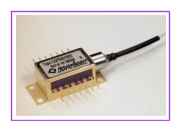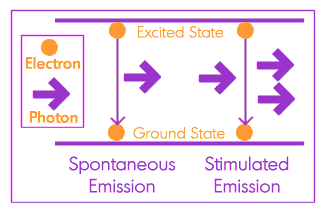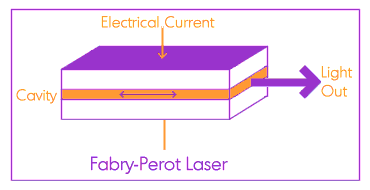Laser Basics
Devices giving out intense light at one specific color
August 1, 2001

Before reading this you may find the following tutorials useful:
Unknown Document 575162, Unknown Document 575162, Unknown Document 575162
The kinds of lasers used in optical networks are tiny devices — usually about the size of a grain of salt. They are little pieces of semiconductor material, specially engineered to give out very precise and intense light. When packaged up they are about the size of a piece of candy and usually have optical fiber coming out of the package, which is accurately aligned to allow the maximum amount of light out of the laser. You may hear them referred to as laser diodes, semiconductor lasers, or laser chips.  Within the semiconductor material are lots of electrons — negatively charged particles. Not just one or two electrons, but billions and billions of them. Some of these electrons can be in what is known as an “excited” state, meaning that they have more energy than regular electrons. An electron in an excited state can just spontaneously fall down to the regular “ground” state. The ground state has less energy, and so the excited-state electron must give out its extra energy before it can enter the ground state. It gives this energy out in the form of a “photon” — a single particle of light.
Within the semiconductor material are lots of electrons — negatively charged particles. Not just one or two electrons, but billions and billions of them. Some of these electrons can be in what is known as an “excited” state, meaning that they have more energy than regular electrons. An electron in an excited state can just spontaneously fall down to the regular “ground” state. The ground state has less energy, and so the excited-state electron must give out its extra energy before it can enter the ground state. It gives this energy out in the form of a “photon” — a single particle of light.
In a laser we want lots of light to come out. If we just wait for electrons to spontaneously “decay” from the excited state to the ground state, we are not going to get much light out at all. So what we need to do first is to get lots of electrons into the excited state. To do this we apply an electric current to the laser, which puts lots of electrons up into this excited state (sometimes referred to as “population inversion”). So we now see more and more spontaneous emission of photons caused by electrons decaying from the excited state to the ground state. But this is still not enough light for what we need. We want lots of these electrons to decay at the same time to give lots of light out, and we want this to be happening all the time so that we have a steady stream of light.
So we now see more and more spontaneous emission of photons caused by electrons decaying from the excited state to the ground state. But this is still not enough light for what we need. We want lots of these electrons to decay at the same time to give lots of light out, and we want this to be happening all the time so that we have a steady stream of light.
We want to catch, or “confine,” the spontaneously emitted photons within the laser. We want them to travel back and forth through the laser time and time again, because these photons can encourage other excited electrons to fall to the ground state and give out more photons. These photons are stimulating emission of further photons, and therefore effectively amplify the light within the device. And all the time an electric current is putting more electrons into the excited state where they wait to fall to the ground state and give out light. Hence we have a LASER — Light Amplification by Stimulated Emission of Radiation (the radiation in this case is light).
The most basic design of laser is known as “Fabry-Perot.” It consists of two specially designed slabs of semiconductor material on top of each other, with another material in between them forming what is known as the “active layer” or “laser cavity.” Electric current flows through the device from the top slab to the bottom, and the emission of light occurs in the active layer. Light travels along this layer until it reaches a reflective end, at which point it bounces back through the active layer again and causes more stimulated emission of light, before bouncing back off the other reflective end, and so forth. The ends are not 100 percent reflective: Usually around 70 percent of the light will be let through. When the light builds up enough within the active layer, a highly intense beam of light is emitted from each end of the laser. There is a specific value of electrical current applied to the laser at which the stimulated emission of light really takes over from the spontaneous emission, and this is known as the “threshold current.” The photons produced from the laser are all of roughly the same wavelength, and so the emitted light beam is very monochromatic, meaning that it is of one color or wavelength. In practice, Fabry-Perot lasers are not entirely monochromatic, and different laser designs — such as distributed feedback (DFB) lasers — are required to give out purer wavelengths.
When the light builds up enough within the active layer, a highly intense beam of light is emitted from each end of the laser. There is a specific value of electrical current applied to the laser at which the stimulated emission of light really takes over from the spontaneous emission, and this is known as the “threshold current.” The photons produced from the laser are all of roughly the same wavelength, and so the emitted light beam is very monochromatic, meaning that it is of one color or wavelength. In practice, Fabry-Perot lasers are not entirely monochromatic, and different laser designs — such as distributed feedback (DFB) lasers — are required to give out purer wavelengths.
Different materials can be used to obtain different wavelengths from the laser. In actual fact, most lasers used in optical networks will operate at wavelengths of around 1300nm or 1550nm, as these are points of minimum loss within optical fibers. These wavelengths are infrared, and so you cannot actually see the light they give out (visible light ranges from red at around 700nm to violet at 400nm). If you did happen to look directly into the end of one while it is switched on, you would risk not seeing anything at all for the rest of your life — the very intense light emitted can cause considerable damage to your eyesight.
Key Points
Tiny salt-grain sized devices made of semiconductor material
Electrical current puts lots of electrons into excited state: population inversion
Excited electrons spontaneously decay to ground state and emit photons
Photons can stimulated emission of further photons
Fabry-Perot cavity confining light and reflecting it back and forth
Most of light at one specific wavelength, but others are produced in Fabry-Perot
Further Reading
Nonlinear Effects, Distributed Feedback (DFB) Lasers, Vertical Cavity Surface Emitting Lasers (VCSELs),Tunable Lasers, Semiconductor Optical Amplifiers (SOAs)
You May Also Like










